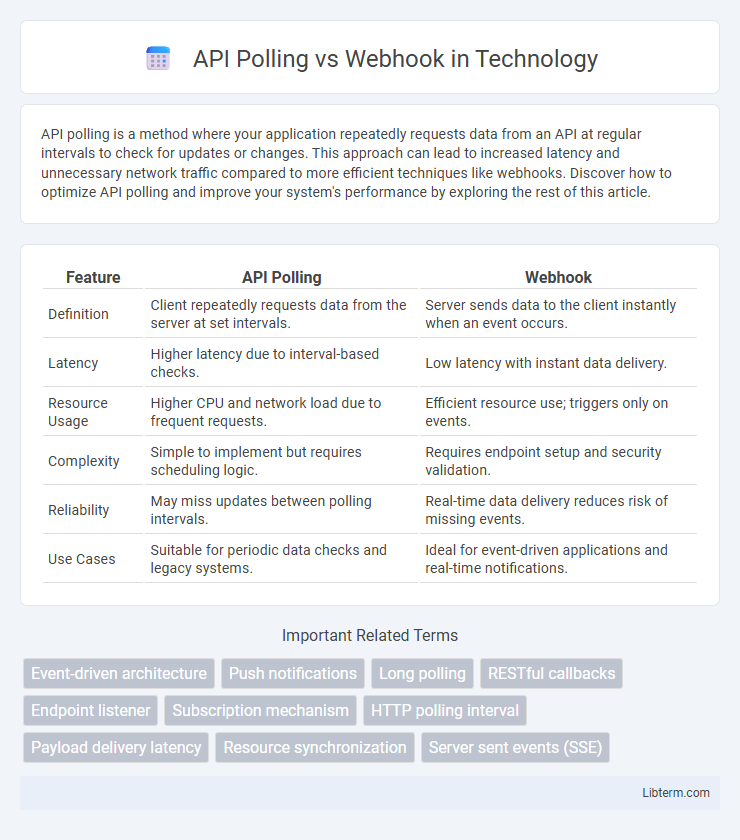API polling is a method where your application repeatedly requests data from an API at regular intervals to check for updates or changes. This approach can lead to increased latency and unnecessary network traffic compared to more efficient techniques like webhooks. Discover how to optimize API polling and improve your system's performance by exploring the rest of this article.
Table of Comparison
| Feature | API Polling | Webhook |
|---|---|---|
| Definition | Client repeatedly requests data from the server at set intervals. | Server sends data to the client instantly when an event occurs. |
| Latency | Higher latency due to interval-based checks. | Low latency with instant data delivery. |
| Resource Usage | Higher CPU and network load due to frequent requests. | Efficient resource use; triggers only on events. |
| Complexity | Simple to implement but requires scheduling logic. | Requires endpoint setup and security validation. |
| Reliability | May miss updates between polling intervals. | Real-time data delivery reduces risk of missing events. |
| Use Cases | Suitable for periodic data checks and legacy systems. | Ideal for event-driven applications and real-time notifications. |
Introduction to API Polling and Webhooks
API polling involves repeatedly sending requests to a server at regular intervals to check for new data or updates, ensuring applications stay synchronized but often causing increased latency and resource consumption. Webhooks operate by having the server push real-time notifications to the client whenever an event occurs, reducing unnecessary requests and improving efficiency for event-driven environments. Both methods facilitate data communication between systems, with polling favoring simplicity and control, and webhooks providing immediacy and lower overhead.
How API Polling Works
API polling works by repeatedly sending requests at regular intervals to a server to check for new data or updates. This method requires the client to initiate each request, which can lead to increased latency and higher resource consumption compared to event-driven communication. The server responds with the current data state, enabling the client to process any changes detected during each polling cycle.
How Webhooks Operate
Webhooks operate by automatically sending real-time data from a server to a client whenever a specific event occurs, using HTTP callbacks to deliver payloads directly to a predetermined URL. Unlike API polling, which requires clients to repeatedly request data, webhooks push updates instantly, reducing latency and server load. This event-driven mechanism enhances efficiency and responsiveness in applications such as payment processing, GitHub notifications, and CRM integrations.
Key Differences Between Polling and Webhooks
API polling involves repeatedly sending requests at regular intervals to check for new data, resulting in increased latency and higher resource consumption. Webhooks operate by pushing data immediately to a specified URL when an event occurs, enabling real-time updates with reduced server load. The key differences lie in efficiency, latency, and resource utilization, with webhooks providing faster, event-driven communication compared to the static, interval-based approach of polling.
Advantages of API Polling
API polling offers consistent and predictable data retrieval intervals, allowing applications to control the frequency of requests based on specific needs or server capacity. It ensures data freshness by repeatedly querying the server, minimizing the risk of missing critical updates during downtime or connectivity issues. Polling is easier to implement in environments lacking support for inbound connections, providing a straightforward method for synchronization without additional infrastructure requirements.
Advantages of Webhooks
Webhooks offer real-time data delivery by pushing updates directly to the client, reducing latency and server load compared to API polling, which requires frequent requests and can increase overhead. This event-driven model enhances efficiency, as webhooks eliminate unnecessary polling intervals and optimize resource utilization, ensuring immediate notification of data changes. Their ability to scale seamlessly makes webhooks ideal for applications demanding timely and efficient communication between systems.
Use Cases for API Polling
API polling is ideal for applications requiring frequent status checks or updates, such as monitoring IoT device health or tracking transaction statuses in payment systems. It suits scenarios where immediate notification is unavailable or unreliable, enabling clients to fetch new data at regular intervals. Polling is also beneficial when the server does not support webhooks or when security policies restrict incoming connections from external sources.
Use Cases for Webhooks
Webhooks excel in real-time data synchronization scenarios where immediate notification of events is critical, such as payment gateway updates, CRM lead capture, or GitHub repository changes. They reduce server load and bandwidth by eliminating the need for constant API polling, making them ideal for systems requiring event-driven architectures. Webhooks enable seamless integration between services, ensuring timely responses to triggers without the inefficiencies of repeated API requests.
Security Considerations for Polling and Webhooks
API polling requires robust authentication and rate limiting to prevent unauthorized data access and mitigate denial-of-service attacks, as frequent requests can expose endpoints to security risks. Webhooks demand stringent validation of incoming requests through HMAC signatures or tokens to verify the sender's identity and protect against replay attacks or payload tampering. Both methods benefit from encrypted HTTPS communication to ensure data integrity and confidentiality during transmission.
Choosing the Right Approach for Your Application
API polling involves repeatedly sending requests to a server at fixed intervals to check for new data, which can lead to increased latency and higher resource consumption. Webhooks deliver real-time updates by pushing data to your application when events occur, reducing unnecessary traffic and improving efficiency. Selecting the right approach depends on your application's responsiveness needs, server capacity, and tolerance for data latency.
API Polling Infographic

 libterm.com
libterm.com